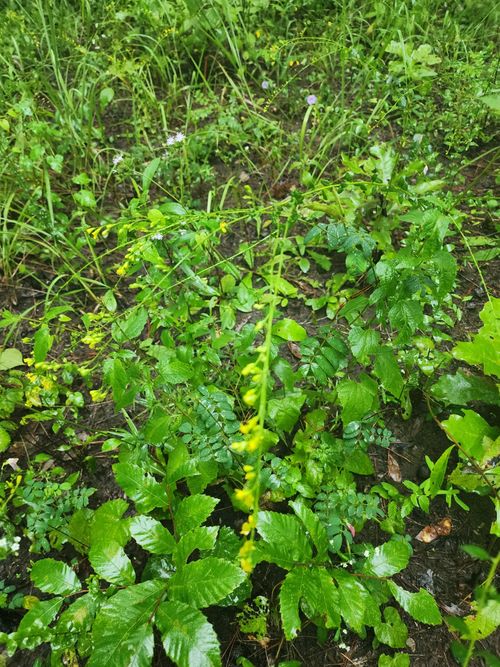There are more than 120 species of butterflies that reside in Massachusetts. All of these species help to pollinate plants and help to move energy through the ecosystem. These butterflies are found in nearly all of the habitats in Massachusetts. In this post we will talk about the four species of swallowtail butterflies (Papilinoidae) that you can host in your butterfly garden on Nantucket Island, Massachusetts.
Table of Contents for Swallowtail Butterflies and Host Plants on Nantucket Island
Location of Nantucket Island, MA

Nantucket Island is located to the south of Cape Cod in eastern Massachusetts and makes up all of Nantucket County.
USDA Plant Hardiness Zones on Nantucket Island, MA

Nantucket Island is located in plant hardiness zone 7b. When selecting plants you will want to get those that can handle temperatures as cold as 50F to be sure they will survive.
Pipevine Swallowtail (Battus philenor) and its host plants on Nantucket Island, MA




Pipevine Swallowtail (Battus philenor)
The pipevine swallowtail flies throughout the United States, except for the Pacific Northwest. On Nantucket Island this species is considered to be a migrant from the mainland.
It has orange-brown eggs that are laid on the host plant. The black to brown to red caterpillar with orange markings comes out in the spring. They then overwinter as a pupa (Monroe and Wright 2017).
In the spring and into the summer the adult butterflies start to fly. They have a wingspan of 2.5 in (6.4 cm) to 5 in (12.7 cm) inches and are black colored with white markings.
Plants that Host the Pipevine Swallowtail
The Pipevine Swallowtail is generally hosted by members of the birthwort family (Aristolochiaceae). There are no records of any members of this family being on the island.
Giant Swallowtail (Papilo cresphontes) may possibly be on Nantucket Island, MA
This species is a stray on the island of Martha’s Vineyard and could potentially be encountered on Nantucket Island as well, but there have been no confirmed sightings.
Eastern Tiger Swallowtail (Papilio glaucus) and its host plants on Nantucket Island, MA

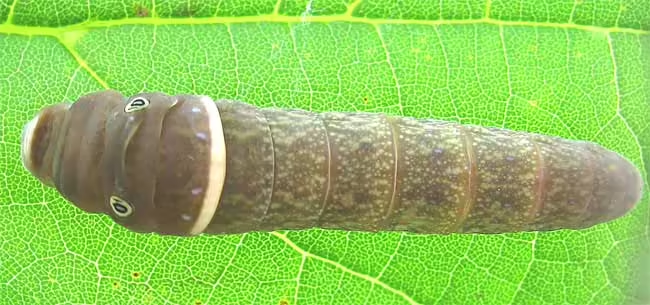

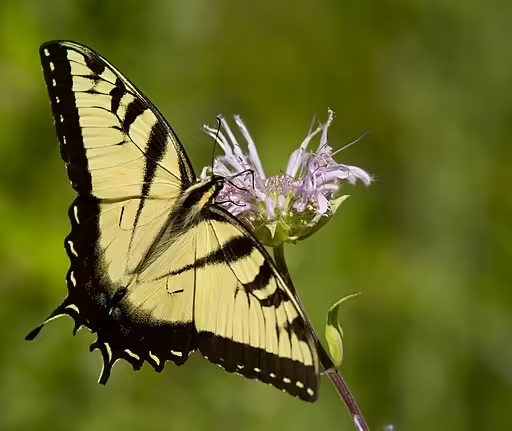

Eastern Tiger Swallowtail (Papilio glaucus)
The Eastern Tiger swallowtail flies in the mid-western and eastern United States from the Rocky Mountains and east. In the Eastern US it is likely one of the most distinctive swallowtails.
The light green eggs are laid on the host plants. The caterpillar has five stages; with the first three a brown color and the last two as a green color. The brown chrysalis is placed in on trunks or on fallen leaves.
The adults have a wingspan of 3 in (7.6 cm) to 5.5 in (14.0 cm) and have two color schemes. The yellow and black is the most distinctive, but the females also have a dark black phase that mimics the pipevine swallowtail (see image). Generally there are two broods in Pennsylvania (Monroe and Wright 2017).
Plants that Host the Eastern Tiger Swallowtail
The eastern tiger swallowtail is a generalist and uses members of a number of genera as host plants. Some species on Nantucket Island include:
- Members of the Prunus genus (Cherries and Plums)
- Members of the Betula genus (Birch)
- Members of the Populus genus (Poplar and Cottonwood)
- Members of the Fraxinus genus (Ash)
- Tuliptree (Liriodendron tulipifera)


Black Swallowtail (Papilio polyxenes) and its host plants on Nantucket Island, MA

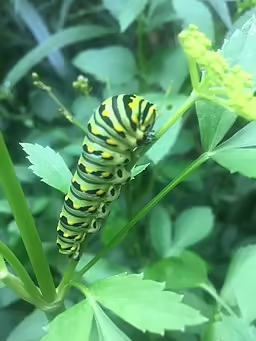

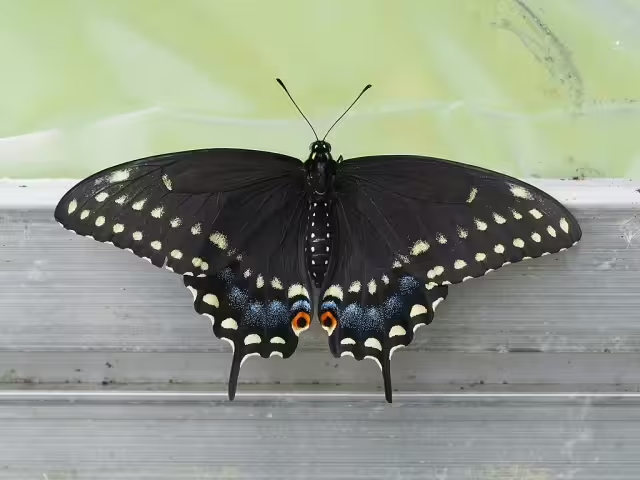
Black Swallowtail (Papilio polyxenes)
The Black Swallowtail flies in most of the United States, except for the Northwest. The yellow eggs are laid on the host plants and take about a week to hatch. The caterpillars are at first black colored but later have green, black, and yellow coloring and last from a week to a month. The butterflies then survive the winter as a chrysalis.
The adults have a wingspan of 2.5 in (6.4 cm) to 3.5 in (8.9 cm) and are black colored with yellow spots along the wings and a red eyepsot near the tail on the top. The underside has orange spots.
Plants that Host the Black Swallowtail
The black swallowtail is a generalist and uses members of the carrot family as host plants. Some examples of carrot family members on Nantucket Island include:
- Seacoast Angelica (Angelica lucida): a herbaceous plant
- Spotted Water-Hemlock (Cicuta maculata): a herbaceous plant
- American Cow-Parsnip (Heracleum maximum): a herbaceous plant
- Aniseroot (Osmorhiza longistylis): a herbaceous plant
- Wild Parsnip (Pastinaca sativa): a herbaceous plant
- Golden Alexanders (Zizia aurea): a herbaceous plant


Spicebush Swallowtail (Papilo troilus) and its host plants on Nantucket Island, MA



Spicebush Swallowtail (Papilio troilus)
The spicebush swallowtail flies in the mid-western and eastern United States. This species is considered to be a stray from the mainland on the island.
The greenish eggs are laid on the leaves of spicebush. The caterpillars are brown at first but then turn yellow. The chrysalis is attached to leaves on the ground. The adults have a wingspan of 3 in (7.6 cm) to 4 in (10.2 cm) and are black with white spots along the bottom and a red eyespot on the bottom middle.
Plants that Host the Spicebush Swallowtail
As the common name would suggest, spicebush (Lindera benzoin) is a host plant for the spicebush swallowtail as is the sassafras (Sassafras albidum), both of which are members of the Laurel Family (Lauraceae). Both of these species are found on Nantucket Island and the spicebush swallowtail only feeds on members of the Lauraceae (Scriber et al 2008).
- Sassafras (Sassafras albidum) — An understory tree


Nectar Plants to Consider Putting in Your Garden

Robert Coxe, Image
While the swallowtails need certain species of plants to use as hosts, the adults also need nectar plants to visit in order get nourishment. Nectar plants can also help other insects such as bees. Some common nectar plants that can be grown on Nantucket Island, MA include:
- Goldenrods (Solidago spp.)
- Joe-Pye-Weeds (Eutrochium spp.)
- Milkweeds (Asclepias spp.) — Also benefit the Monarch Butterfly (Danaus plexippus)
- Asters (Symphyotrichum spp.)
- Coneflowers (Rudbeckia spp.)
- Blazing Stars (Liatris spp.)
Frequently Asked Questions
How much land do I need to start a butterfly garden?
Every plant that you can grow can make a difference for visitors to your garden, especially in urban areas. Potted plants are also useful en masse for pollinators. When planting your garden, make sure you plant both the host plants and nectar plants for the adults to feed on.
Where should I get my plants?
For pollinators, it is best to have native plant species. The insects will be used to these plants more than ones from other places. Be sure you get your plants from a reputable nursery does not use neocontinids that would harm visitors to your garden.
Are there gardens near me, where I can see an example of a butterfly garden?
There are no formal butterfly gardens on the island of Nantucket. However there are a lot of residential and private gardens that can be visited at certain times of the year. For more information, visit the Nantuket Garden Club.
Books where you can find out more about Butterfly Gardening on Nantucket Island, MA
- Ahern, Jack. 2022. Design with Nature on Cape Cod and the Islands. University of Massachusetts Press. 238 pp.
- Daniels, Jaret C. 2022. Garden Bugs & Insects of the Northeast: Identify Pollinators, Pests, and Other Garden Visitors. Adventure Quick Guides.
- Daniels, Jaret C. 2022. Native Plant Gardening for Birds, Bees & Butterflies. Northeast – Nature Friendly Gardens. 276 pp.
- Daniels, Jaret C. 2019. Butterflies of the Northeast. Adventure Publications.
- Leske, Staci N. 2006. The Butterfly That Loved the Firefly. Author Solutions Inc. 108 pp.
- Lorimer, Uli. 2022. The Northeast Native Plant Primer: 235 Plants for an Earth-Friendly Garden. Little Brown Publishers. 250 pp.
- Owen, Maria Louisa. 2022. A Catalogue of Plants Growing Without Cultivation in the County of Nantucket, Mass. Creative Media Partners, LLC. 88 pp.
Affiliate Disclosure: When you click on links to various merchants on this site and make a purchase, this can result in this site earning a commission at no extra cost to you. Affiliate programs include, but are not limited to, the eBay Partner Network and Blackwell’s Books.
References
- Monroe, James L. and David M. Wright. 2017. Butterflies of Pennsylvania. (Pittsburgh, PA: University of Pittsburgh Press). 304 pp.
- Scriber, Mark J., Michelle L. Larsen, and Myron P. Zalucki. 2008. Responses of North American Papilio troilus and P. glaucus to potential hosts from Australia. Journal of the Lepidopterists’ Society 62: 18-30.

